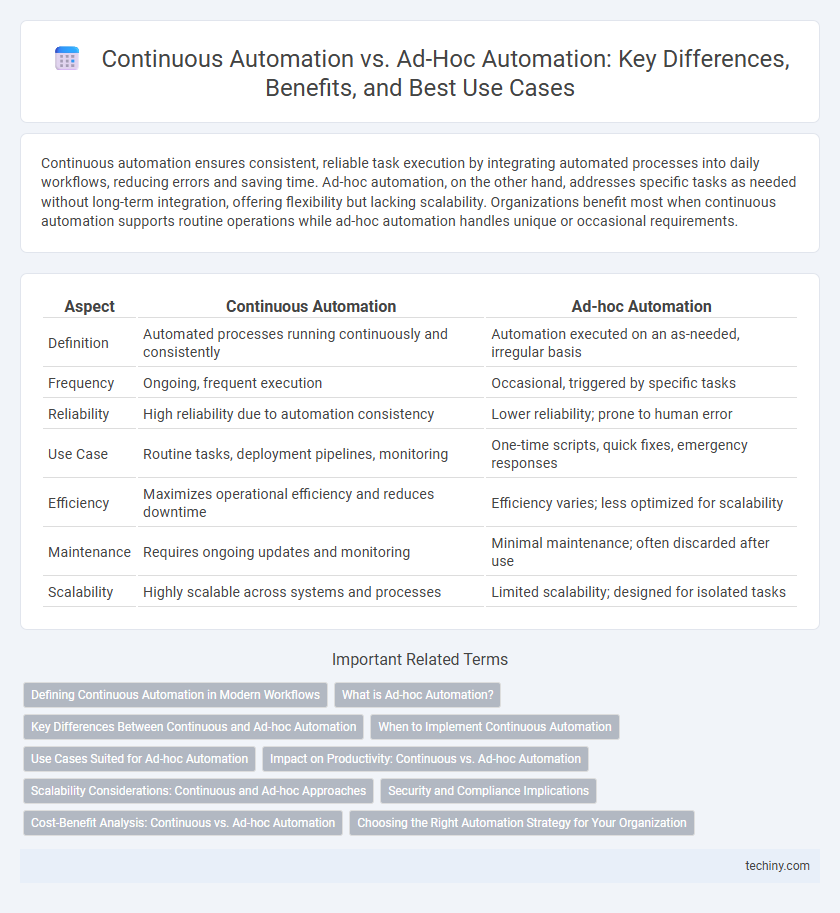Continuous automation ensures consistent, reliable task execution by integrating automated processes into daily workflows, reducing errors and saving time. Ad-hoc automation, on the other hand, addresses specific tasks as needed without long-term integration, offering flexibility but lacking scalability. Organizations benefit most when continuous automation supports routine operations while ad-hoc automation handles unique or occasional requirements.
Table of Comparison
| Aspect | Continuous Automation | Ad-hoc Automation |
|---|---|---|
| Definition | Automated processes running continuously and consistently | Automation executed on an as-needed, irregular basis |
| Frequency | Ongoing, frequent execution | Occasional, triggered by specific tasks |
| Reliability | High reliability due to automation consistency | Lower reliability; prone to human error |
| Use Case | Routine tasks, deployment pipelines, monitoring | One-time scripts, quick fixes, emergency responses |
| Efficiency | Maximizes operational efficiency and reduces downtime | Efficiency varies; less optimized for scalability |
| Maintenance | Requires ongoing updates and monitoring | Minimal maintenance; often discarded after use |
| Scalability | Highly scalable across systems and processes | Limited scalability; designed for isolated tasks |
Defining Continuous Automation in Modern Workflows
Continuous Automation in modern workflows involves the seamless integration of automated tasks across all stages of a business process, enabling real-time updates and consistent operational efficiency. It ensures automated activities are systematically executed without manual intervention, supporting ongoing monitoring and instant adjustments. This approach contrasts with ad-hoc automation by emphasizing scalability, repeatability, and persistent improvement within dynamic environments.
What is Ad-hoc Automation?
Ad-hoc automation refers to the implementation of automation tasks on a case-by-case basis, targeting specific problems or processes without a long-term, repeatable strategy. It typically involves quick, tactical solutions designed to address immediate needs rather than integrating into a holistic automation framework. This approach contrasts with continuous automation, which emphasizes ongoing, scalable, and systematic automation across operations.
Key Differences Between Continuous and Ad-hoc Automation
Continuous automation involves the ongoing, systematic execution of automated processes to ensure consistent, real-time performance improvements, while ad-hoc automation refers to sporadic, task-specific automation implemented as needed without long-term integration. Key differences include the level of process integration, with continuous automation embedded into workflows for scalability and reliability, whereas ad-hoc automation lacks standardized implementation, leading to limited reuse and potential inefficiencies. Continuous automation emphasizes continuous monitoring and feedback loops, contrasting with the isolated, one-off nature of ad-hoc automation that can hinder optimization and adaptability.
When to Implement Continuous Automation
Continuous automation should be implemented when repetitive tasks within software development or IT operations require consistent and reliable execution to enhance efficiency and reduce errors. It is ideal for environments with frequent code changes, continuous integration, and delivery pipelines, where automated workflows ensure faster feedback and deployment cycles. Adopting continuous automation in such scenarios maximizes scalability, minimizes manual intervention, and supports agile methodologies effectively.
Use Cases Suited for Ad-hoc Automation
Ad-hoc automation excels in addressing specific, one-off tasks such as data cleanup, one-time report generation, or urgent error correction that do not justify the investment in continuous automation pipelines. Use cases suited for ad-hoc automation often involve irregular or unpredictable workflows where flexibility and rapid deployment are critical. This approach reduces overhead for processes lacking repetitive frequency or volume necessary for full-scale continuous automation implementation.
Impact on Productivity: Continuous vs. Ad-hoc Automation
Continuous automation significantly enhances productivity by enabling consistent and repeatable task execution, reducing errors, and minimizing manual intervention. In contrast, ad-hoc automation offers short-term gains but often leads to inefficiencies due to its sporadic and unstructured nature. Enterprises leveraging continuous automation achieve higher scalability and operational efficiency, making it superior for sustained productivity growth.
Scalability Considerations: Continuous and Ad-hoc Approaches
Continuous automation enables scalable workflows by integrating consistent, repeatable processes that adapt to evolving business needs, reducing manual intervention and errors. Ad-hoc automation, while flexible for immediate tasks, lacks the framework needed for long-term scalability and often results in fragmented, isolated solutions. Organizations prioritizing growth benefit from continuous automation's systematic approach to scaling across multiple environments and use cases.
Security and Compliance Implications
Continuous automation ensures consistent application of security policies and compliance standards through automated monitoring and real-time enforcement, reducing the risk of human error and vulnerabilities. In contrast, ad-hoc automation can create security gaps due to irregular updates and inconsistent adherence to compliance frameworks, increasing the likelihood of non-compliance penalties. Implementing continuous automation in DevOps pipelines enhances auditability and compliance reporting by maintaining comprehensive logs and traceability.
Cost-Benefit Analysis: Continuous vs. Ad-hoc Automation
Continuous automation delivers long-term cost savings by streamlining repetitive tasks and reducing manual intervention, enhancing overall operational efficiency. Ad-hoc automation involves higher short-term costs due to frequent setup and customization but offers flexibility for specific, one-time processes. Evaluating cost-benefit analysis reveals continuous automation yields superior ROI in scalable environments, while ad-hoc suits limited or irregular workflows with minimal upfront investment.
Choosing the Right Automation Strategy for Your Organization
Continuous automation integrates automated processes into all stages of a workflow, ensuring consistent, scalable, and repeatable results that enhance productivity and reduce errors over time. Ad-hoc automation targets specific, isolated tasks for immediate efficiency gains without extensive initial setup or long-term integration. Selecting the right automation strategy depends on organizational goals, resource availability, and the complexity of processes, with continuous automation offering sustained improvement and ad-hoc automation providing quick wins for discrete activities.
Continuous Automation vs Ad-hoc Automation Infographic

 techiny.com
techiny.com